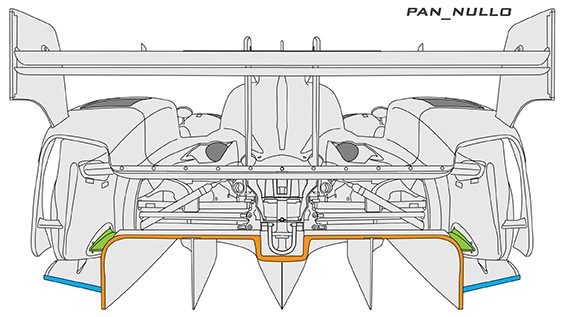08/06/2023 -
6H at Spa Francorchamps is as usual last opportunity to prepare and test cars for the golden appointment of WEC season: 24H of Le Mans.
2023 is certainly dense of contents considering lot of cars either LMH an LMDh taking the start of this evergreen classis.
Despite Balance of Performance and Homologation process, that affect aerodynamics design approach, the great aspect is that most of the cars are following quite distinctive aero concept and still showing similar performance on track.
Let’s review briefly front and rear view of the cars, outlining most interesting concepts on aero design.
Toyota GR010 front aero is based on a front splitter with a curved upward pressure side that incorporates air ducts. Above we find a “beam wing” with full span inside fenders and relatively large chord, building up a significant area of this element.
Dive planes, just above the splitter, shows rear cut as on typical Toyota design on this components.
Rear view shows rear diffuser with almost rectangular shape, and two vertical strakes. Interesting to note that Toyota is the sole car that use trailing edge cone behind rear wheel, inside fender, with small device that bridge this cone to rear diffuser end plate.


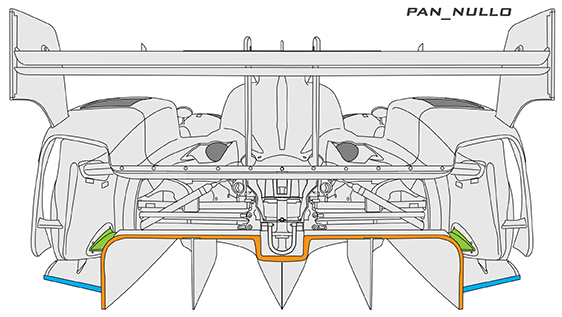
Toyota GR010 – front and rear view
Peugeot 9x8 front aero shows a splitter with blown flap (green elements) and upper airfoil shape (pink).
Dive plane has extended area, small attack angle and is design to generate downforce using positive pressure zone ahead of front fender nose.
Rear view is certainly the most discussed area since car presentation, introducing the wingless approach.
We can note great expansion area of rear diffuser with wide channels on the side. Small aspect ratio wings, with 2 elements each are collocated at tail side edge within end plates and inner fins. Coloured in green we see tall nolders added during car development, a shorter span device in the centre and extended pairs at the sides.

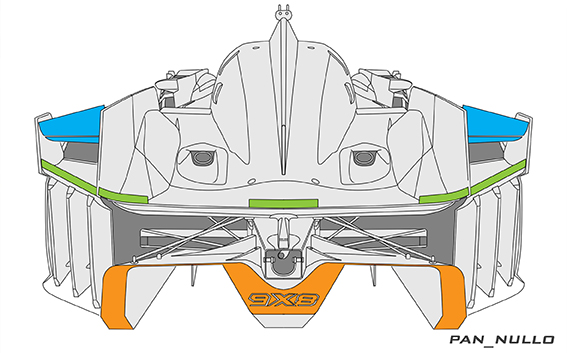
Peugeot 9x8 – front and rear view
Ferrari 499 shows what I consider the most sophisticated front aero design.
Splitter is raised within front wheels to increase airflow under the nose that is then managed with couple of turning vanes below. We have a front wing where main is the splitter and 2 blown flaps are above with overlaps between trailing edge and leading edge of next element downstream.
Nolders and curved surfaces are located on top of fenders just ahead of the slots over the wheel.
Rear diffuser has curved trailing edge which provides great expansion area on the center portion. Vertical strakes are absent. Nolders are placed at the side of top bodywork with a full span elements on the top.
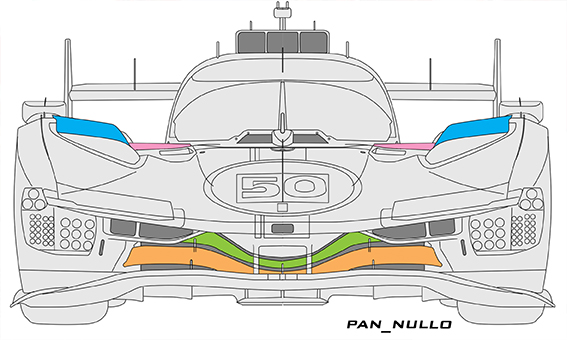

Ferrari 499P – front and rear view
Front splitter on Glickenhaus 007 has a straight centre portion with single element flap between nose and inside fenders. An extended chord element is just above creating a channel on the front and guiding the flow around the blunt nose.
Rear view looks like high performance GT car and this is surely the family feeling that the Constructor wanted to obtain.
Diffuser has two vertical strakes on each side and constant height along the span. Nolder is placed along entire curvy trailing edge of the rear bodyworks.
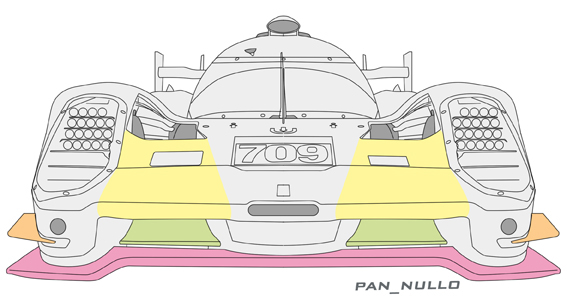

Glickenhaus 007– front and rear view
Front aero on Vanwall Vandervell 680 shows four elements double wings principle. Primary wings works on ground effect, with splitter acting as main and blown flap (red) with full span just at his trailing edge. Narrow nose leaves great span for the second raised wing collocated between inside fender and nose. Main element here (pink) shows a considerable curvature on his mean camber line, working with an inverse tapered blown flap (yellow). Chord and local attack angles are reduces moving from the tip toward the centreline. Interesting to note the slot on the flap at fender inner portion, a way to maintain local downforce with greater efficiency than could be obtains with full chord.
Rear view looks more conventional with a diffuser with linear trailing edge, a pair of strakes and curved surface elements just behind the wheel, extracting downforce from the wakes.
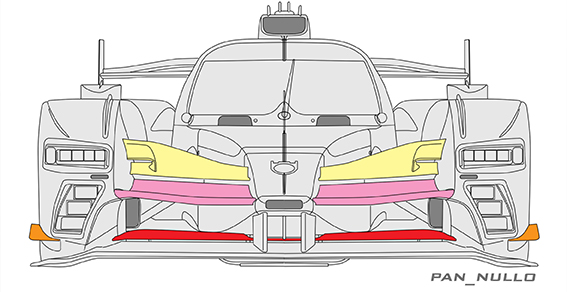
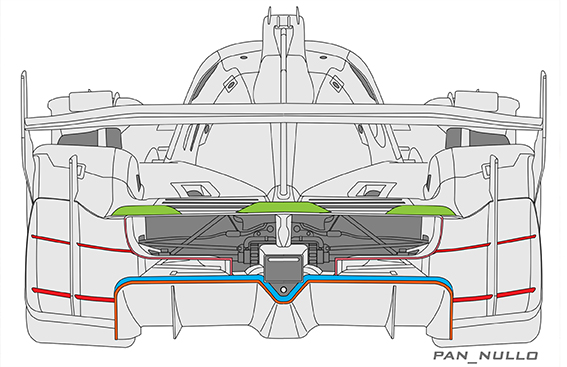
Vanwall Vandervell 680 - front and rear view
Acura LMDh at first look resemble LMP2 concept. Front splitter shape, convex surface on top parts around the nose and proportion of the fenders. Interesting the top wing elements collocated above the front nose bridging inside surface of fenders. Important span and moderate chord without relevant twist and taper, integrating light design that is distinctive style of this car.
Rear view shows rectangular cones behind rear wing that are at the side of diffuser. Height of top trailing edge is moderate with constant transversal section at the exit. A pair of turning vanes on the bottom are dividing the expansions channels, with a concept quite familiar from the time of LMP2.
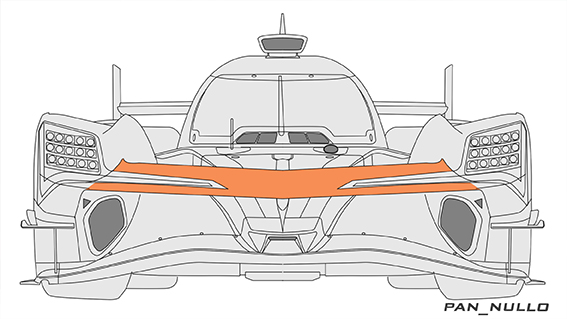

Acura LMDh - front and rear view
Front splitter on BMW LMDh doesn’t have a raised center part, but the single element flap appears just behind the BMW iconic style logo. Dive planes are of small area collocated with reduced attack angle.
Rear diffuser is not significantly extended in vertical direction, with central cuspid and bottom surface behind rear wheels again like on LMP2 car. Turning vanes on diffuser under channel are very dissimilar in longitudinal extension and collocation, comparing the ones in the inside part with the others closest to rear diffuser endplate.


BMW LMDh - front and rear view
Cadillac V LMDh has the front areo concept designed around a single flap splitter.
Edges are bent downward, with the center portion raised to work with underflow. Top part is a single entity that connects nose and fenders with their leading edges extended forward.
Rear view has a massive fences behind rear wheels that span across rear width, it is the sole cars with this configuration. A curvy nolder, is placed on trailing edge of rear bodyworks.
Diffuser has constant height and squared side edges.


Cadillac V- LMDh- front and rear view
Porsche 963 LMDh belongs to the group of cars with front fender configured with single flap.
Front portion of fenders and nose are merged in a single narrow leading edge forming a channel between pressure side of the splitter and volume above. Ventilation open area on top of front fenders have reduced dimensions sidewise, smaller than all other cars, and collocated close to the wheel arc. Two vanes are collocated above the canopy, diverging rearwards.
Rear view shows a rectangular constant height diffuser and again ventilation panel on top of rear fenders with narrow width and positioned very close to rear wheel arc.
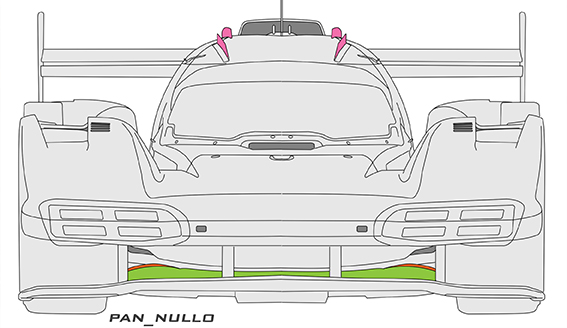

Porsche 963 LMDh- front and rear view
As we briefly review all cars are based on different shapes and aero concept. Considering the homologation process conducted in wind tunnels, measuring downforce and drag at different front and rear ride height, this is the proof that aeromap can falls within tight limits regardless the variety of bodyworks shape, front splitter and rear diffuser designs.

